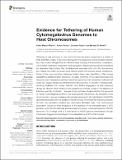Files in this item
Evidence for tethering of human cytomegalovirus genomes to host chromosomes
Item metadata
| dc.contributor.author | Mauch-Mücke, Katrin | |
| dc.contributor.author | Schön, Kathrin | |
| dc.contributor.author | Paulus, Christina | |
| dc.contributor.author | Nevels, Michael M. | |
| dc.date.accessioned | 2020-09-30T15:30:02Z | |
| dc.date.available | 2020-09-30T15:30:02Z | |
| dc.date.issued | 2020-09-30 | |
| dc.identifier | 269685484 | |
| dc.identifier | b2162466-9650-45fd-9051-ab3f6bf577b0 | |
| dc.identifier | 000577563300001 | |
| dc.identifier | 85091767356 | |
| dc.identifier.citation | Mauch-Mücke , K , Schön , K , Paulus , C & Nevels , M M 2020 , ' Evidence for tethering of human cytomegalovirus genomes to host chromosomes ' , Frontiers in Cellular and Infection Microbiology , vol. 10 , 577428 . https://doi.org/10.3389/fcimb.2020.577428 | en |
| dc.identifier.issn | 2235-2988 | |
| dc.identifier.other | ORCID: /0000-0002-7115-407X/work/81406014 | |
| dc.identifier.other | ORCID: /0000-0002-4123-5629/work/81406031 | |
| dc.identifier.uri | https://hdl.handle.net/10023/20706 | |
| dc.description | This work was supported by the Deutsche Forschungsgemeinschaft (NE791/2-2) and the Wellcome Trust Institutional Strategic Support Fund. | en |
| dc.description.abstract | Tethering of viral genomes to host chromosomes has been recognized in a variety of DNA and RNA viruses. It can occur during both the productive cycle and latent infection and may impact viral genomes in manifold ways including their protection, localization, transcription, replication, integration and segregation. Tethering is typically accomplished by dedicated viral proteins that simultaneously associate with both the viral genome and cellular chromatin via nucleic acid, histone and/or non-histone protein interactions. Some of the most prominent tethering proteins have been identified in DNA viruses establishing sustained latent infections, including members of the papillomaviruses and herpesviruses. Herpesvirus particles have linear genomes that circularize in infected cell nuclei and usually persist as extrachromosomal episomes. In several γ-herpesviruses, tethering facilitates the nuclear retention and faithful segregation of viral episomes during cell division, thus contributing to persistence of these viruses in the absence of infectious particle production. However, it has not been studied whether the genomes of human Cytomegalovirus (hCMV), the prototypical β-herpesvirus, are tethered to host chromosomes. Here we provide evidence by fluorescence in situ hybridization that hCMV genomes associate with the surface of human mitotic chromosomes following infection of both non-permissive myeloid and permissive fibroblast cells. Tethering appears to occur at lower frequency in the absence of the immediate-early 1 (IE1) proteins, which bind to histones and have been implicated in the maintenance of hCMV episomes. Our findings point to a mechanism of hCMV genome maintenance through mitosis and suggest a supporting but non-essential role of IE1 in this process. | |
| dc.format.extent | 11 | |
| dc.format.extent | 1408548 | |
| dc.language.iso | eng | |
| dc.relation.ispartof | Frontiers in Cellular and Infection Microbiology | en |
| dc.subject | Human herpesvirus | en |
| dc.subject | Human cytomegalovirus | en |
| dc.subject | Immediate-early 1 | en |
| dc.subject | Viral episome | en |
| dc.subject | Genome maintenance | en |
| dc.subject | Chromatin tethering | en |
| dc.subject | Mitotic chromosome | en |
| dc.subject | Fluorescence in situ hybridization | en |
| dc.subject | QR Microbiology | en |
| dc.subject | DAS | en |
| dc.subject.lcc | QR | en |
| dc.title | Evidence for tethering of human cytomegalovirus genomes to host chromosomes | en |
| dc.type | Journal article | en |
| dc.contributor.sponsor | The Wellcome Trust | en |
| dc.contributor.institution | University of St Andrews. School of Biology | en |
| dc.contributor.institution | University of St Andrews. Biomedical Sciences Research Complex | en |
| dc.identifier.doi | https://doi.org/10.3389/fcimb.2020.577428 | |
| dc.description.status | Peer reviewed | en |
| dc.identifier.url | https://www.frontiersin.org/articles/10.3389/fcimb.2020.577428/full#supplementary-material | en |
| dc.identifier.grantnumber | en |
This item appears in the following Collection(s)
Items in the St Andrews Research Repository are protected by copyright, with all rights reserved, unless otherwise indicated.

